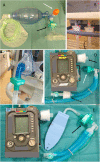Preparing your intensive care unit for the COVID-19 pandemic: practical considerations and strategies
- PMID: 32393325
- PMCID: PMC7213774
- DOI: 10.1186/s13054-020-02916-4
Preparing your intensive care unit for the COVID-19 pandemic: practical considerations and strategies
Abstract
The coronavirus disease 2019 (COVID-19) has rapidly evolved into a worldwide pandemic. Preparing intensive care units (ICU) is an integral part of any pandemic response. In this review, we discuss the key principles and strategies for ICU preparedness. We also describe our initial outbreak measures and share some of the challenges faced. To achieve sustainable ICU services, we propose the need to 1) prepare and implement rapid identification and isolation protocols, and a surge in ICU bed capacity; (2) provide a sustainable workforce with a focus on infection control; (3) ensure adequate supplies to equip ICUs and protect healthcare workers; and (4) maintain quality clinical management, as well as effective communication.
Keywords: Coronavirus disease 2019; Critical care; Infection control; Pandemic preparedness; SARS-CoV-2.
Conflict of interest statement
The authors have no conflict of interests to declare.
Figures


Comment in
-
Rapid establishment of an ICU using anesthesia ventilators during COVID-19 pandemic: lessons learned.Crit Care. 2020 Jun 30;24(1):388. doi: 10.1186/s13054-020-03107-x. Crit Care. 2020. PMID: 32605580 Free PMC article. No abstract available.
References
-
- WHO Director-General’s opening remarks at the media briefing on COVID-19 - 11 March 2020. Available: https://www.who.int/dg/speeches/detail/who-director-general-s-opening-re.... [cited 12 Mar 2020].
Publication types
MeSH terms
LinkOut - more resources
Full Text Sources
Medical
Miscellaneous

